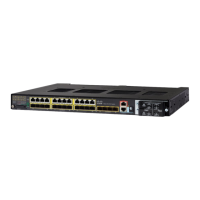832
Configuring IP Unicast Routing
Configuring OSPF
EXAMPLE
The following example sets your OSPF network as a broadcast network:
interface serial 0
ip address 192.168.77.17 255.255.255.0
ip ospf network broadcast
encapsulation frame-relay
The following example illustrates a point-to-multipoint network with broadcast:
interface serial 0
ip address 10.0.1.1 255.255.255.0
encapsulation frame-relay
ip ospf cost 100
ip ospf network point-to-multipoint
frame-relay map ip 10.0.1.3 202 broadcast
frame-relay map ip 10.0.1.4 203 broadcast
frame-relay map ip 10.0.1.5 204 broadcast
frame-relay local-dlci 200
!
router ospf 1
network 10.0.1.0 0.0.0.255 area 0
neighbor 10.0.1.5 cost 5
neighbor 10.0.1.4 cost 10
Configuring OSPF Area Parameters
You can optionally configure several OSPF area parameters. These parameters include authentication for
password-based protection against unauthorized access to an area, stub areas, and not-so-stubby-areas (NSSAs). Stub
areas are areas into which information on external routes is not sent. Instead, the area border router (ABR) generates a
default external route into the stub area for destinations outside the autonomous system (AS). An NSSA does not flood
all LSAs from the core into the area, but can import AS external routes within the area by redistribution.
Route summarization is the consolidation of advertised addresses into a single summary route to be advertised by other
areas. If network numbers are contiguous, you can use the area range router configuration command to configure the
ABR to advertise a summary route that covers all networks in the range.
Note: The OSPF area router configuration commands are all optional.
BEFORE YOU BEGIN
Evaluate the following considerations before you implement this feature:
You can set a Type 7 default route that can be used to reach external destinations. When configured, the router
generates a Type 7 default into the NSSA or the NSSA ABR.
Every router within the same area must agree that the area is NSSA; otherwise, the routers will not be able to
communicate.

